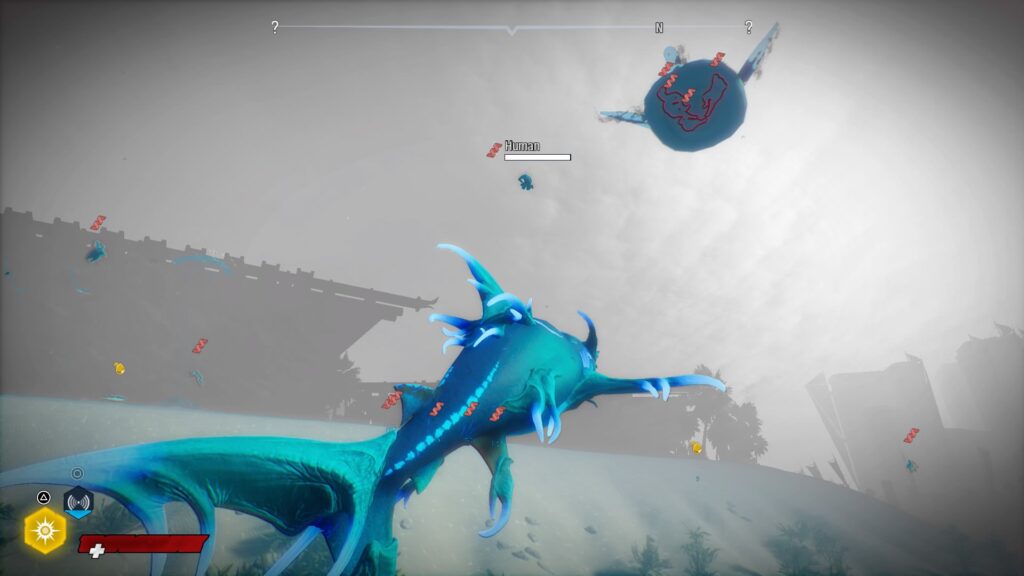
Tripwire Interactive has a long history making military shooters that pride themselves on their realism, authenticity, and brutally serious depiction of various conflicts. The Red Orchestra and Rising Storm games have a ridiculous amount of attention to detail, all in the developer’s pursuit of making games that try their best to accurately depict battles from WWII or Vietnam.
To give you an idea of the devotion to realism I’m talking about, the M16s in Rising Storm 2: Vietnam only hold 18 rounds in their 20 round mags because the early rifles were prone to ammo feed problems.
On the opposite end of the spectrum, you have Killing Floor, a franchise that revels in being completely absurd and over-the-top. As you can imagine from a “shark RPG,” Maneater leans on the Killing Floor side of the spectrum. The result is one of the most refreshingly stupid, hilarious, and nonsensical games I’ve played in a while.
Maneater
Developer: Tripwire Interactive
Publisher: Deep Silver (Console versions)
Platforms: Windows PC, Nintendo Switch, PlayStation 4 (Reviewed), Xbox One
Release Date: May 22nd, 2020
Players: 1
Price: $39.99

Maneater‘s story is presented in the style of a reality docudrama TV show, like Deadliest Catch or River Monsters. The game’s cutscenes are being “filmed” by the camera crew of a fictional show called Maneaters, which follows shark hunters that patrol the Gulf Coast.
The story is mostly focused on Scaly Pete, a veteran shark hunter and the captain of the fishing vessel, the Cajun Queen. Scaly Pete is the game’s main antagonist, and is completely obsessed with killing sharks due to his past. This often leads to disputes with his son Kyle, who is currently studying to become a marine biologist while helping his father out on the Cajun Queen during summer break.
You play as a bull shark that was mutilated and left for dead by Scaly Pete following the shark hunt that killed your mother. Driven by an insatiable hunger for vengeance, you now have one goal in life: to eat Scaly Pete.
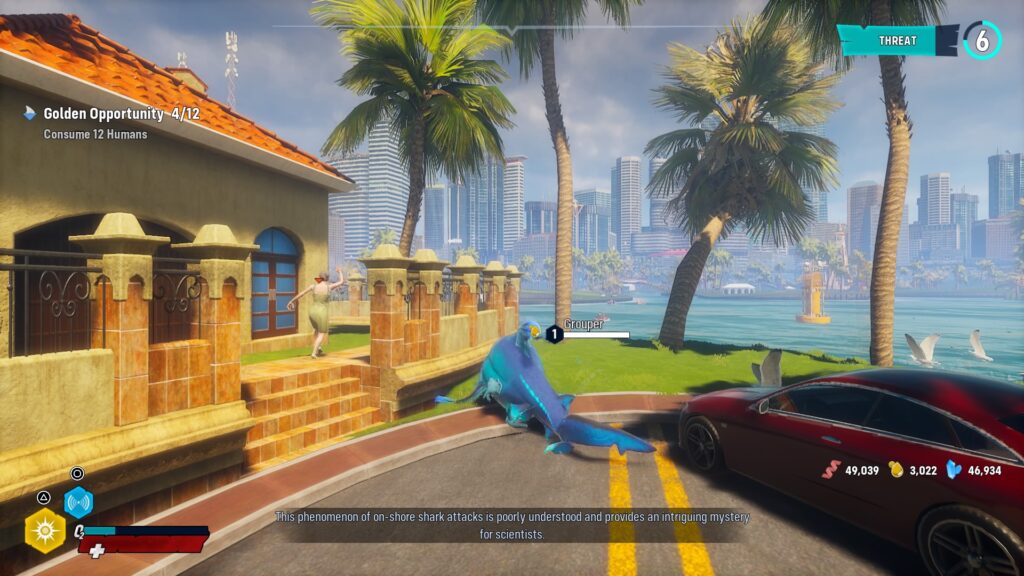
I went into Maneater expecting a lot of dumb and mindless fun. What I didn’t expect to find was a surprisingly decent story with some pretty good writing. Scaly Pete is a pretty interesting villain with a surprisingly tragic backstory. Maneater‘s story certainly won’t be winning any grand awards for its originality, but its entertaining enough to keep you engaged the whole way through.
The hilarious narration by Chris Parnell certainly helps. Chris plays as a disembodied voice that acts as the narrator for the in-game TV series. He regularly chimes in, commenting on your actions throughout the game like this is the world’s snarkiest nature documentary.
His lines range from random facts about marine wildlife; to snarky, sarcastic, or satirical remarks. Many of them are hilarious, and the game satirizes such topics as animal rights activism, environmentalism, the tourism industry, and more. There’s also a fair number of well-timed pop culture references sprinkled in. This extends to the game’s quests, which are often horrible puns like this:
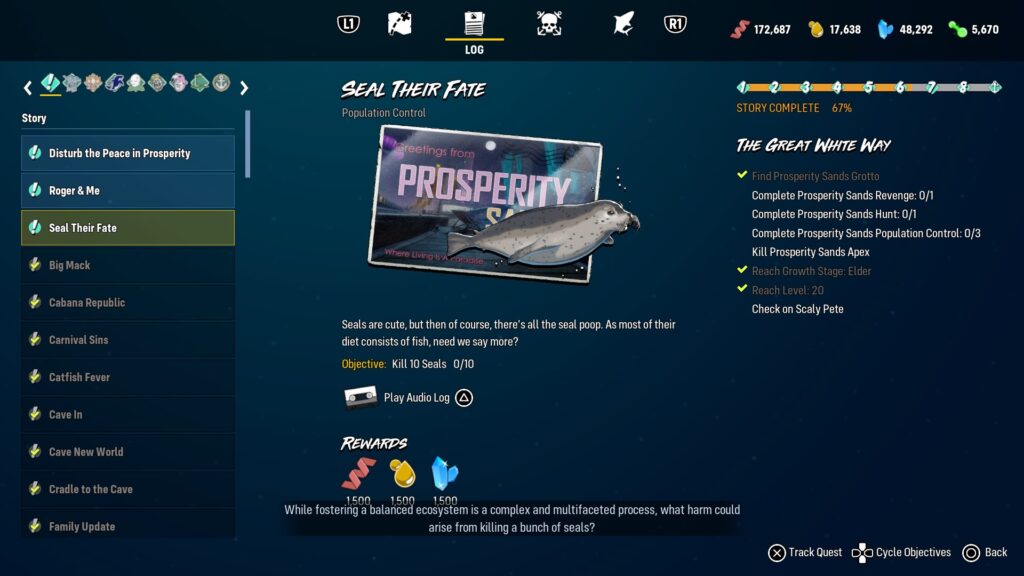
The actual gameplay loop of Maneater is pretty par for the course for an open world pseudo-RPG. The world is divided into eight maps, each of which are full of story missions, side quests, collectables, and tons of animals (and people) to devour.
You are given a checklist of things to do in a map before you are allowed to move on. Usually this involves doing the story missions, completing about 50% of the collectables and side missions, reaching a certain level, and so on. You’ll often run into areas of a map you’ll need to come back to later after leveling up a bit more.
Each area also has an Apex Predator that appears after you’ve completed a certain number of quests. These are the game’s boss fights, and typically involve taking on a larger, more powerful version of a marine creature you’ve already encountered.
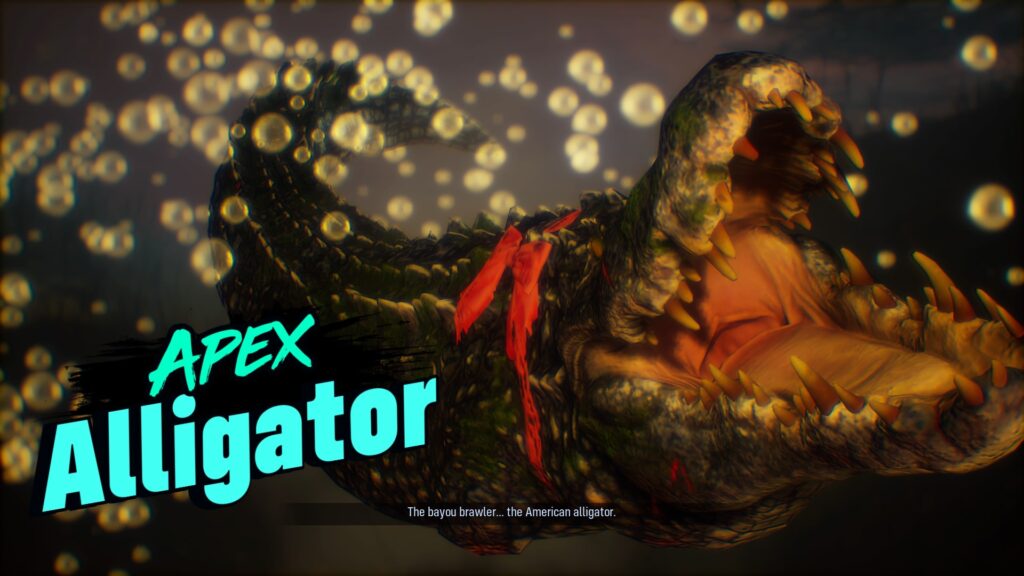
Seeing as how this is a game about being a shark, all the quests generally revolve around eating stuff. While that isn’t unexpected, it does mean that the game is fairly repetitive, as every quest you’ll encounter is basically “eat X number of creature Y.” Side quests usually involve fighting (and eating) a specific animal, or terrorizing a beach.
The game’s collectibles involve finding landmarks, medical crates, and license plates. These are all worth locating, because they give you experience, resources to level up your skills, and after hitting certain thresholds, you’ll be rewarded with new skills.
You start the game as a pup chasing after catfish while dodging alligators in a bayou. At specific points in the story you’ll grow, with the other forms being teen, adult, and elder. Each growth spurt is accompanied by a stat boost and access to some new moves.
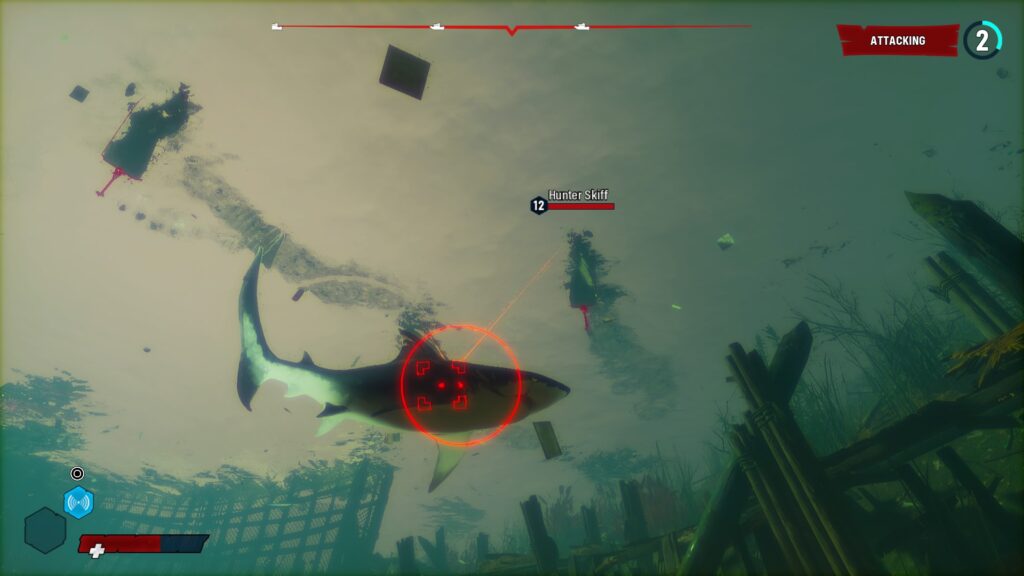
Seeing as how you are a shark, your primary means of fighting are your teeth. You have access to some basic bite combos. If you are large enough, you can also latch onto your prey when they are vulnerable.
This initiates a thrash move, allowing you to shake your shark’s head back and forth using the analog stick to deal continuous damage. This goes both ways, meaning creatures that are larger than you can grab hold of you, forcing you to jerk around the analog stick to break free.
Your shark also has a tail whip, and can perform quick dodges and lunges. Later on, you’ll gain access to some truly absurd moves, like the ability to grab hold of something with your jaws, then use your tail to “throw” it at another enemy.
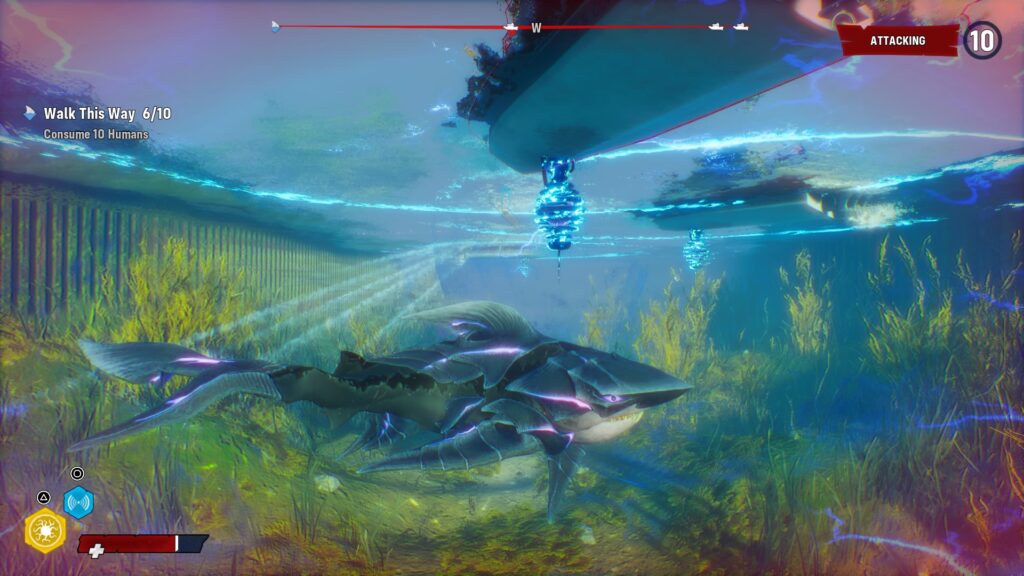
There is an echolocation-like ability to aid with navigation. This highlights all nearby creatures, and tips you off to any hidden collectables.
While underwater, you can freely swim around in any direction. This is helpful when fighting aquatic beasts, but inconvenient when trying to munch on boats and stalk beachgoers. This is where knifing comes in.
When you swim to the surface, the game locks you in place, allowing you to skim along just under the water with your fin exposed. From here, you can leap into the air, landing on boats to chew on the yummy humans inside.
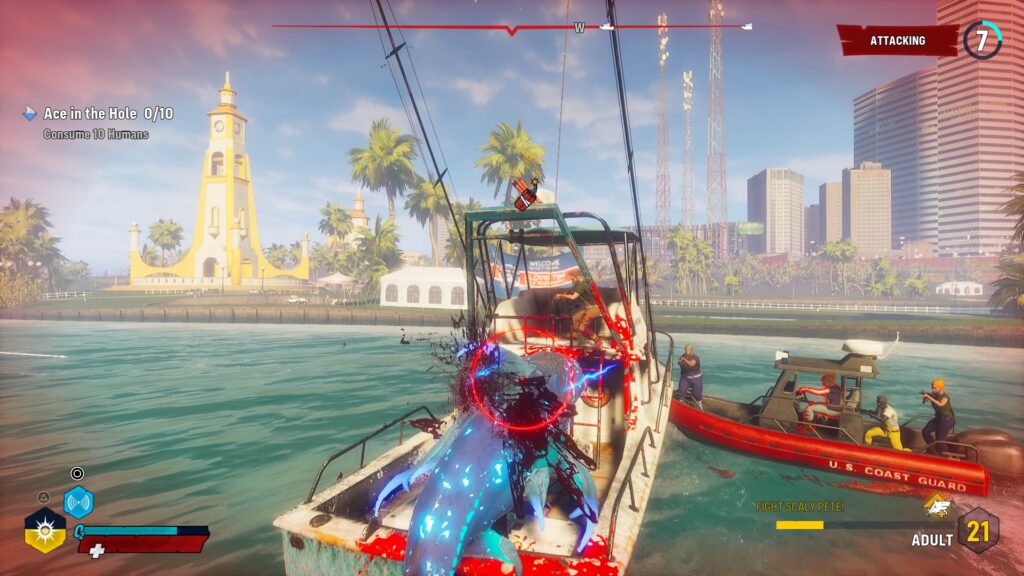
You can also jump onto land for a limited time, which is equal parts janky and hilarious because the shark’s physics engine jiggles and freaks out like the boobs on a Dead or Alive character.
I must admit that the game’s underwater combat takes a lot of getting used to. The first area is set in a rather shallow bayou, and it’s very easy to unintentionally enter the knifing position while dodging past an alligator’s lunge attack.
This is extremely frustrating because the camera then shifts to the surface so you can’t see your foe lurking in the depths below. Luckily, the other maps are all much deeper, meaning this slowly becomes less of an issue over time.
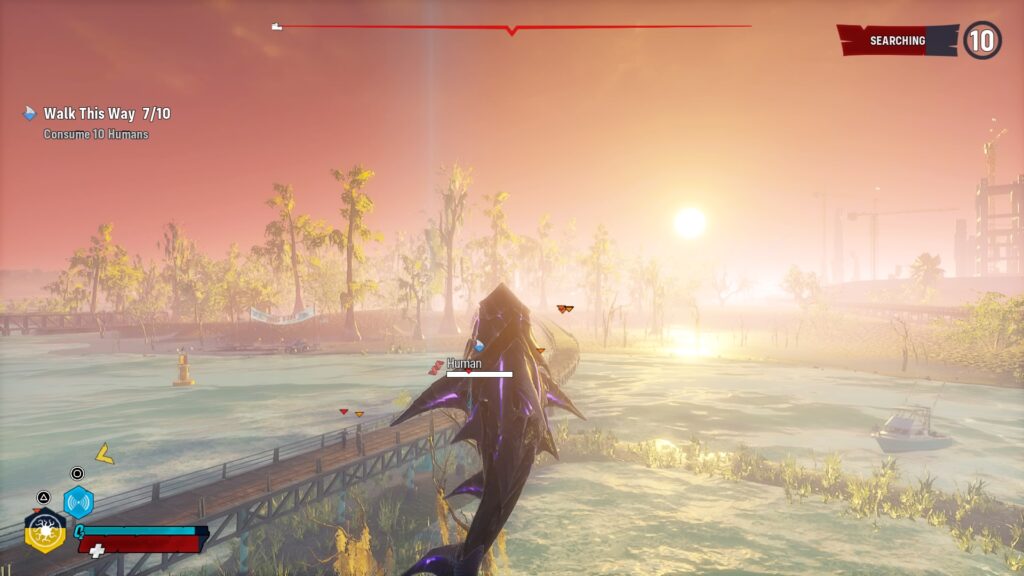
It doesn’t help that Maneater doesn’t really have a proper targeting system. When you get close to a juicy fish, a yellow reticle will appear and create a soft lock, but its a tad imprecise. You can press the right analog stick to focus in on a nearby enemy, but it doesn’t actually track them.
As you dodge and weave through the water while fighting a rival shark, you’ll need to keep moving the camera around and clicking the analog stick to keep your foe in your field of view.
This approach to the targeting system can be a bit finicky at times, and can cause a fair amount of frustration in the game’s first few hours as you learn its intricacies.
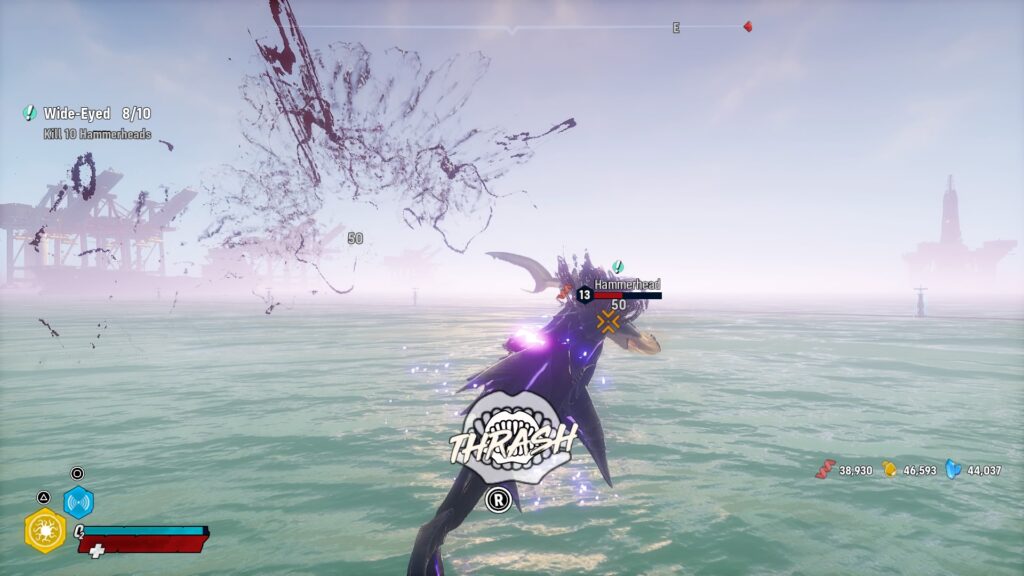
Where Maneater‘s combat really shines, however, is when fighting shark hunters. The game has a wanted system akin to Grand Theft Auto, where a bounty will be placed on you after you start eating people.
This will dispatch some shark hunters in boats to track you down. Jumping through the air, snatching a shark hunter off the prow of a ship, and quickly devouring him never ceases to be fun.
You can also just outright destroy boats by ramming them enough. This becomes easier as your shark gets bigger, and there is a chance you can knock people off boats by ramming them hard enough. You can also jump onto boats Jaws-style, and start tearing through their cabins as you devour the shark hunters onboard.
The composition of the bounty hunters sent against you depends on your Infamy. This ties into one of the game’s side activities. As you cause havoc, your Infamy gauge will fill. When it levels up, a professional shark hunter will be sent after you. These are effectively mini-bosses, and there are 10 in all.

The bounty hunters start as a ragtag group of fishermen on airboats with shotguns, but as your Infamy grows, the efforts to kill you will escalate. Eventually you will be fighting US Coast Guard patrol boats and heavily-armed militias that are effectively the Blackwater USA of fishermen clubs.
Of course this wouldn’t be an RPG without character progression, and this is where Maneater goes from absurd to downright bonkers. You gain access to special skills and upgrades by completing quests and side activities.
Your shark can have three passive skills equipped at once. These range from powering up your sonar, to increased health, to gaining a load of stat increases when low on health, and so on.
The area where things get really insane is the body part sets. Your shark has a head, teeth, body, fins, and tail slot, and there are three sets in the game: Bone, Shadow, and Bio-Electric. Each set is associated with a specific quest chain, and each one is absolutely absurd.
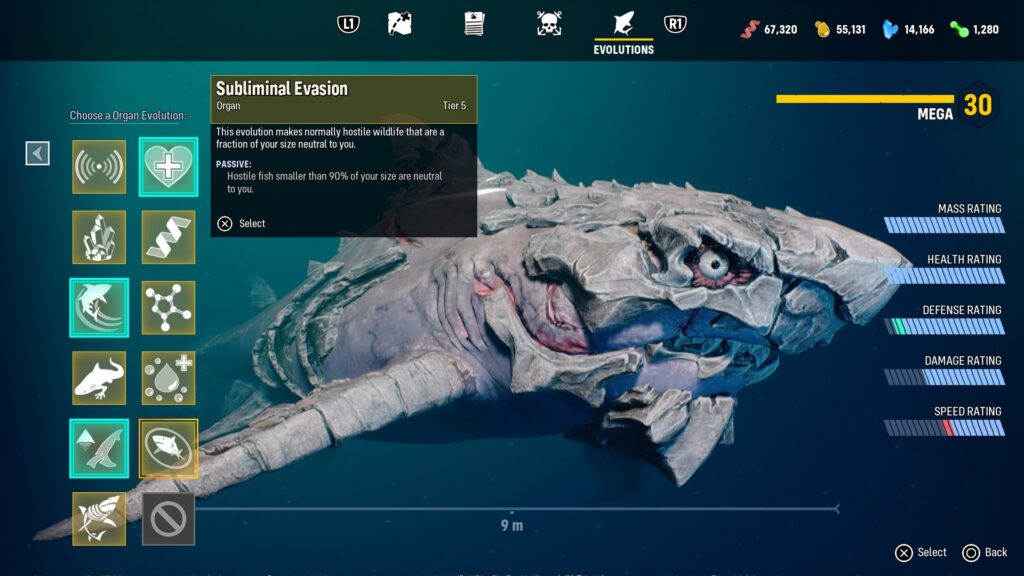
The Bone set is all about survivability. It also increases your damage against boats, and buffs up your mass to make ramming attacks more devastating. The Shadow set is your speedy rogue archetype. It makes you faster, more maneuverable, and focuses on health regen and poison effects. Finally, the Bio-Electric body focuses on AOE damage and stun effects.
Each individual part grants you different passive buffs that alter an aspect of your shark. For example, the Bio-Electric teeth bounce electrical damage to nearby enemies and throw out stun counters, while the Shadow teeth add a health drain to your bites. Tail parts modify your tail whip, fin parts modify your dodge, and so on.
If that wasn’t enough, the bodies all feature an ultimate attack that charges as you devour your foes. The Shadow body releases a poison cloud and slows time, the Bio-Electric body generates a static field that damages and stuns enemies you swim past, and the Bone body buffs your damage and survivability.
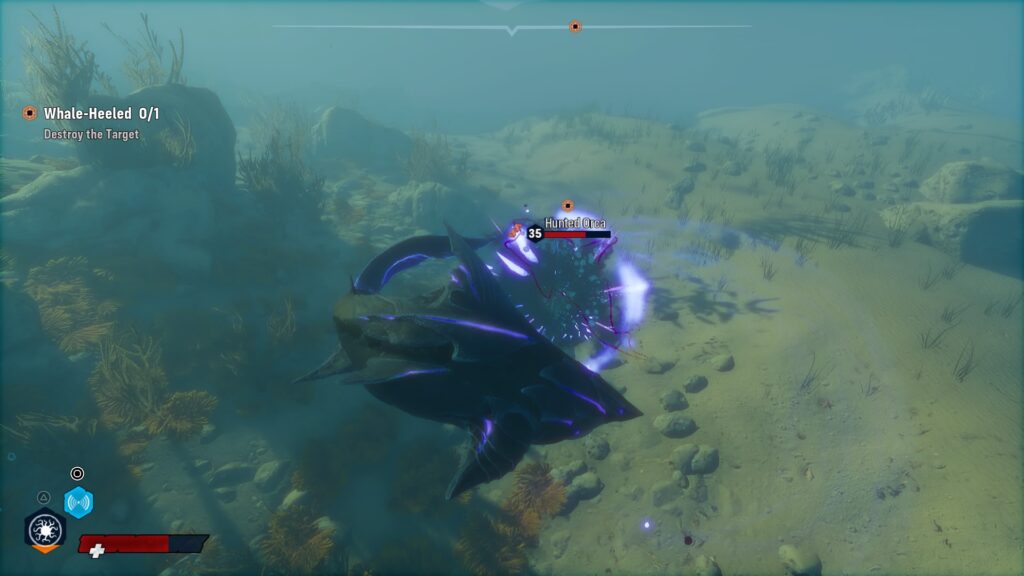
While your shark gains generic experience that levels you up as you eat, there are also four resources in the game: Fats, Protein, Minerals, and Mutagen. These resources are spent to upgrade your skills, and each type of animal gives you a different resource when devoured. An example of each would be seals dropping Fats, mahi-mahi dropping Protein, and turtles dropping Minerals.
Mutagen is a rarer resource that is only used for higher tier skill levels. You don’t need as much of it as the other resources, and its typically found by eating albino variants of animals, or as a reward from quests and collectibles.
Each skill has five tier levels, and follow a fairly linear progression path. Basically, you just spend the requisite resources and the skill’s bonuses become more significant.
While the shark progression isn’t as deep as most other RPGs on the market, each skill is useful and meaningful in its own way. The progression system isn’t particularly grindy either, as you’ll be swimming in resources and experience if you take the time to do side quests and find collectibles.
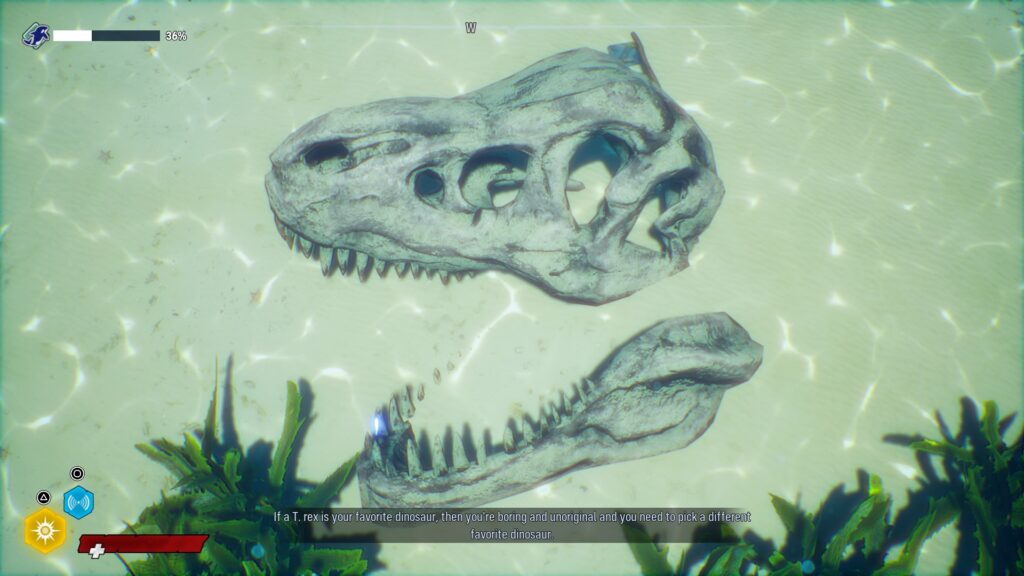
In fact, the game’s progression curve is arguably too forgiving. If you are taking the time to find collectibles and do all the side objectives, then it is very easy to over-level.
I took the time to 100% the first few areas and was stuck in the progression system for a while. I was about five levels over the minimum required to reach the elder stage, but couldn’t because your shark’s growth spurts are tied to the story quests.
My obsession with getting everything also meant that I hit the game’s level cap long before I reached the final confrontation with Scaly Pete. By that time I also had every skill in the game at tier five, so I was carrying around a few hundred thousand in each resource and nothing left to spend them all on.
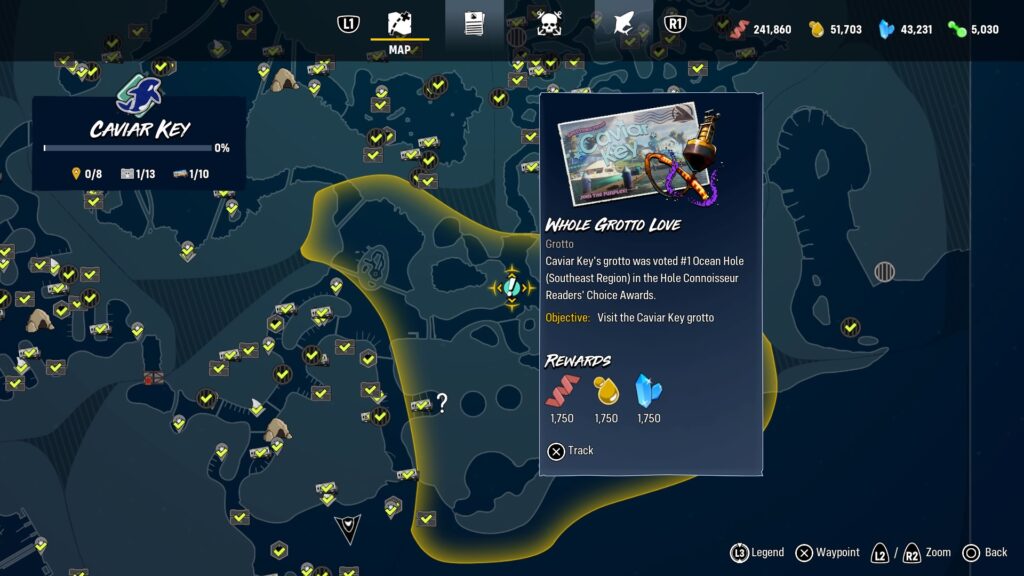
Ultimately though, my biggest problems with Maneater stem from the quality of the PlayStation 4 port itself. The PlayStation 4 version’s performance is pretty abysmal at times; with frequent, massive framerate drops.
These framerate drops are most apparent in the larger battles against bounty hunters once you have a full set of shark gear. There is a lot going on at any given time, and the Bio-Electric skills in particular tend to produce lots of bright particle effects that no doubt contribute to the frame drops.
The PlayStation 4 version is also prone to crashing. I had about two or three crashes in my time with the game, but I’ve heard that some people have it much worse. Also, while I never encountered it myself, I have seen reports of a rare bug in the PlayStation 4 version that can reset your save game progress.
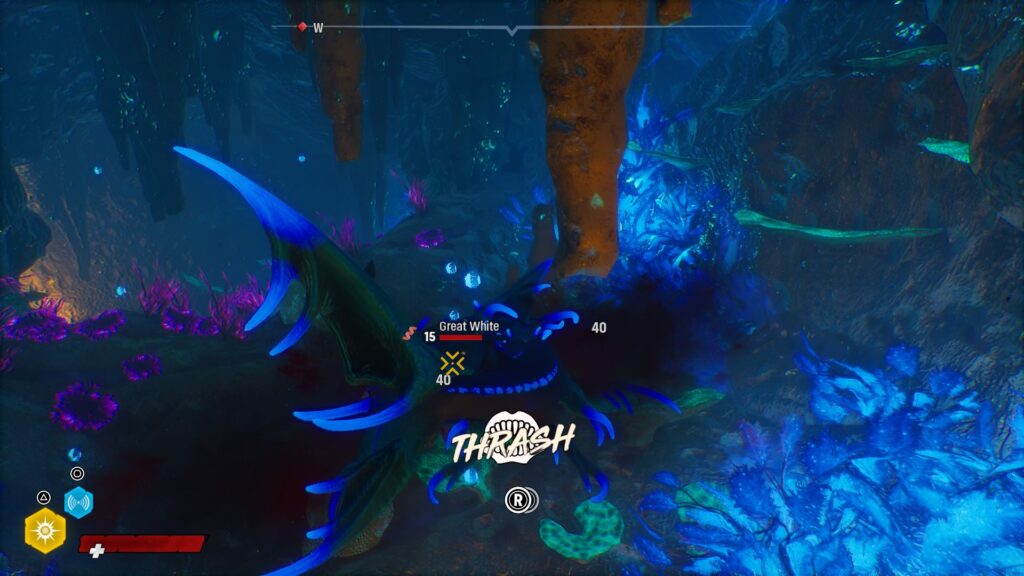
This is a shame, because the game actually looks fairly good. The eight maps are surprisingly varied in terms of color palette and themes. You’ll be swimming through a murky bayou one moment, to a crystal-clear maze of canals surrounded by golf courses and expensive gated communities the next. The various underwater caves you’ll find are particularly stunning, and are full of bioluminescent plants.
There’s a good variety of aquatic animals too, though some seemingly obvious choices, like rays and dolphins, are oddly missing. While the humans look a bit odd, the fish themselves all look great and are well-animated. The animations do get a little janky at times, particularly when your massive shark is bouncing along across the beach, or clipping through the sea turtle it is currently ravaging with its jaws.
Another problem, though admittedly a fairly minor one, is that Maneater‘s critters suffers from what I like to call Video Game Wildlife Syndrome. You probably know exactly what I’m talking about before I even explain myself.
Simply put, everything in Maneater wants to kill you, even if said thing is way below your level. Its pretty easy to accidentally aggro multiple creatures from completely different species, leading to such absurd situations as a Mako shark deciding to team up with an orca to fight you.
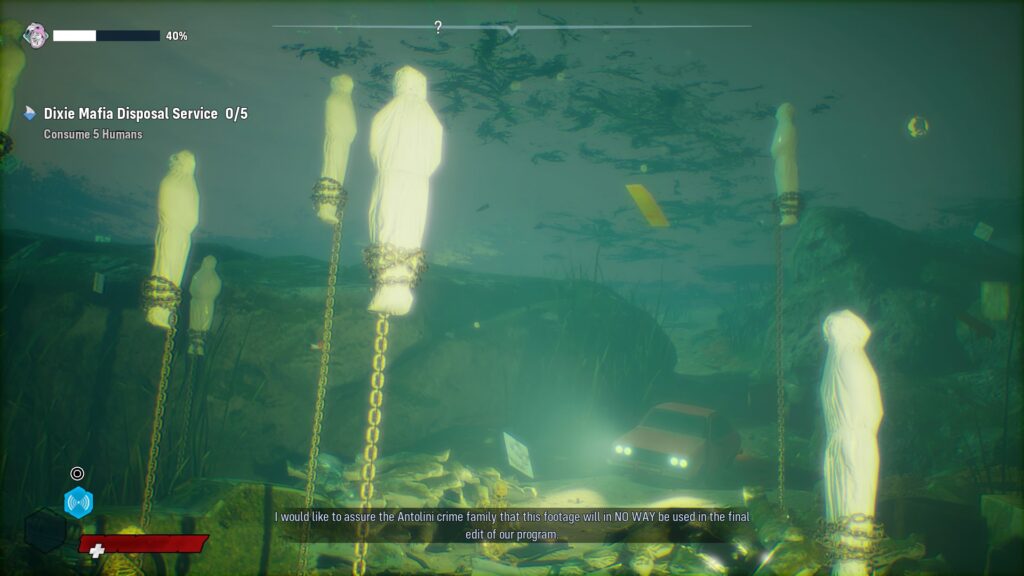
This can also lead to the dreaded “you can’t fast travel while in combat” message because a three-foot long barracuda decided it wanted to fight what is essentially a megalodon that shoots lightning from its fins.
There is a skill that makes creatures that are smaller than you neutral, but I got that skill so late into the game that I never even used it. Not that you’d ever want to since it takes up one of your three precious skill slots.
When you get right down to it, Maneater is an extremely stupid, absurd, mindless, and completely over-the-top game. The game fully understands just how dumb it is, embraces it, and then cranks it up by becoming even more absurd.
Maneater never tries to be anything more than a completely ridiculous shark sim full of gory kills, mindless slaughter, and fantastical upgrades that turn your massive shark into a poison-spewing vampire that can slow down time.
In that regard, Maneater is a very refreshing game. It’s not particularly deep, and can get fairly repetitive, but its a really unique game that just wants you to have fun. It took me about 17 hours over the course of a weekend to completely 100% the game, and I don’t regret doing so.
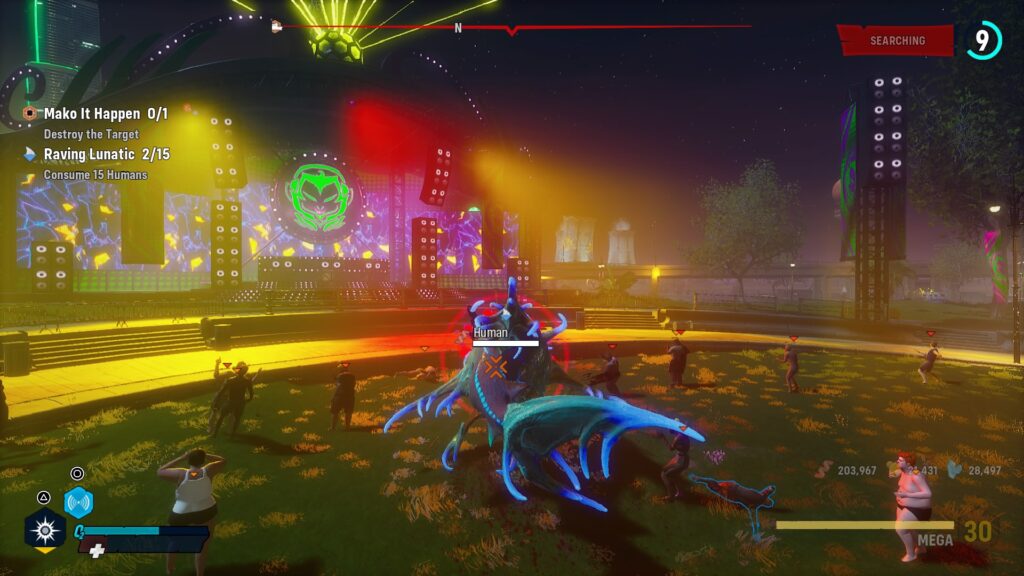
Ultimately, my biggest problems with Maneater are less the game itself, and more the PlayStation 4 version. The massive frame drops can really affect playability and targeting during particularly large and risky fights.
If I had played the game on my PC where I could get higher graphical fidelity and better performance, I’d probably say Maneater is a solid 8/10 game, though the PC version is regrettably an Epic Games Store exclusive for now.
If you want to turn your brain off, terrorize some beachgoers, and become a massive prehistoric predator capable of crushing a great white shark between your jaws, then Maneater is a fine way to spend a weekend. It’s a game that doesn’t try to be anything more than just stupid, ridiculous fun.
Maneater was reviewed on PlayStation 4 using a personal copy. You can find additional information about Niche Gamer’s review/ethics policy here.